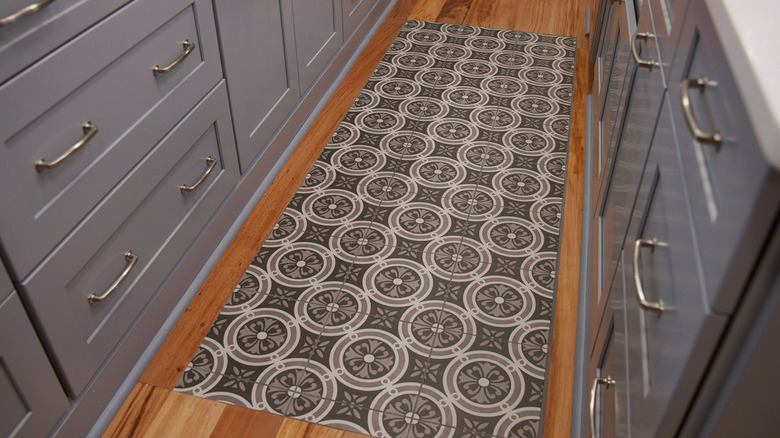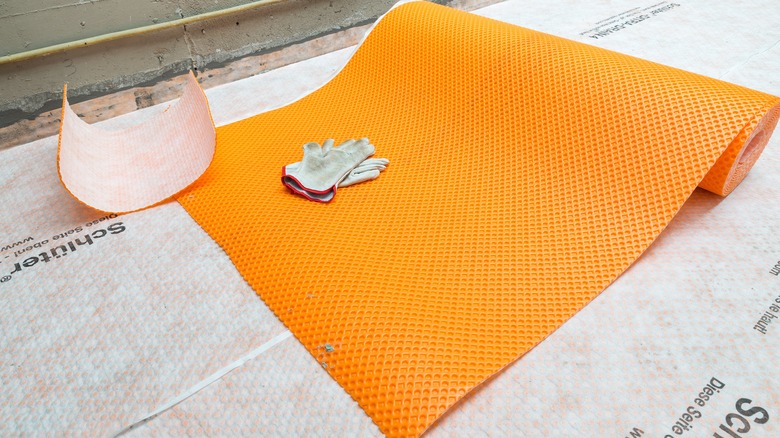Tough Love: Hilary Farr's Genius Kitchen Flooring Tip For Messy Cooks
We may receive a commission on purchases made from links.
Hilary Farr of HGTV's "Tough Love with Hilary Farr" isn't the first designer to drop a bit of tile in the middle of a wood floor, but she knows when it's the best approach. Adding tile to a hardwood floor to armor an area of the kitchen or bathroom is a genius way to avoid the wear and potential damage that makes some hesitant about wood floors where there's so much traffic and water — and so many spills by children and careless cooks. In the episode titled "Two Generation Renovation," Farr presents the idea of adding tile after stating the kitchen will need the same floors as the adjacent rooms.
The idea of running hardwood through a kitchen initially prompts a flurry of objections. Homeowner Amber mentions water spills and escaped ice cubes, and Farr later jokingly blames the whole thing on Amber's partner, Juan, for being "such a messy cooker." But really, it's the solution to a design problem: Farr wants to get the home as close to open concept as possible, which means running the same flooring throughout.
When Amber objects, citing uneven wear and potential damage, Farr gives her a choice between a rug and a tiled area that's "the equivalent of a runner." It's not much of a conundrum, and Amber immediately opts for the tile inlay. Her reaction is priceless: "Why doesn't everybody do that? That's brilliant." Farr's reply is perfect, "Well, not everyone's brilliant," which is true but, in this case, a little strange because the idea is so simple and obvious.
Tile Inlay Design Choices
There are both design and technical challenges involved in floating a little island of tile in a sea of hardwood. The design issues are mostly a matter of color and inventiveness. The tile pattern should complement the decor of the kitchen, of course, even when it also provides a lot of contrast. And, it won't necessarily be one of the best tile colors for a kitchen with no hardwood. The goal is visual cohesion, but don't get carried away and use a tile that doesn't have enough contrast to clearly stand out.
The shape of the tiled area is a little more complicated. It's natural to carve out a long, rectangular area between a kitchen counter and island, but adding tile to an entryway or the center of a room opens up your options. You can, for example, create an irregularly shaped area with edges that interlace with the hardwood flooring for a lovely and dramatic effect. Just take care to not align the wood and tile patterns too closely. You wouldn't necessarily want square tiles the same size as square parquet or long tiles that match the dimensions of hardwood planks. Too much alignment and similarity in size can lead to a tile zone that looks like a patch. If these design issues are matters of style, the technical needs of a project like this are matters of durability and safety. They turn out to be closely related.
Some Technical Issues to Keep in MInd
When it comes to installation, the inset zone of the tile has to be level with the surrounding hardwood to avoid a tripping hazard. OSHA says that a change in floor height of as little as ¼ inch can be dangerous, and in some situations (children, fatigue, physical disability), that measurement can be even smaller. You must measure the thickness of every component of your tile inlay against the thickness of your hardwood to make sure they match precisely.
While some advocate for installing tile directly onto the existing substrate, most advise using a backer product like cement backer board, cement fiber board, foam backer, self-leveling underlayment, or a decoupling membrane under the tile. There's a lot to learn before buying your flooring underlayment, and you must account for the height of whichever you use as well as all layers of thin-set or other adhesives.
For durable tile inlays, using a decoupling membrane like Schluter's Ditra ($1.80 per square foot at Home Depot) or Laticrete's Strata_Mat ($2.01 per square foot at Amazon) isolates the tiles from any movement in the framing or the subfloor, making it far less likely to crack over time. With backer board, which is typically both glued and attached with fasteners, the tile moves with the subfloor. This can add stress at the edges, so use a caulk with some give around the perimeter of your tile. Overall, the decoupling membrane approach is both easier to install and more appropriate to the particular needs of mixing hardwood flooring and tile.


